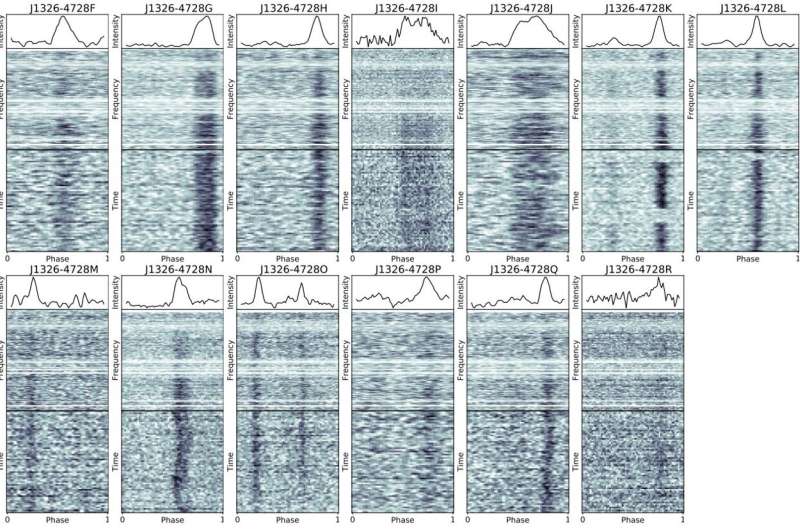January 18, 2023 report
This article has been reviewed according to Science X's editorial process and policies. Editors have highlighted the following attributes while ensuring the content's credibility:
fact-checked
peer-reviewed publication
trusted source
proofread
Thirteen new pulsars discovered with MeerKAT

Using the MeerKAT radio telescope, astronomers from the Max Planck Institute for Radio Astronomy (MPIfR) in Bonn, Germany and elsewhere, have detected 13 new pulsars in the globular cluster Omega Centauri. The finding was detailed in a paper published in the Monthly Notices of the Royal Astronomical Society.
Pulsars are highly magnetized, rotating neutron stars emitting a beam of electromagnetic radiation. They are usually detected in the form of short bursts of radio emission; however, some of them are also observed via optical, X-ray and gamma-ray telescopes.
Now, a team of astronomers led by MPIfR's Weiwei Chen reports the discovery of new pulsars in Omega Centauri (also known as NGC 5139)—the largest globular cluster in our galaxy, located some 17,000 light years away. To date, only five pulsars have been identified in this cluster.
"We used the superior sensitivity of the MeerKAT radio telescope to search for pulsars in Omega Centauri.... In this paper, we presented the discovery of 13 new pulsars in Omega Centauri, which more than tripled the population of known pulsars in this cluster," the researchers wrote.
The new pulsars (designated from PSR J1326−4728F to PSR J1326−4728R) were found within the core and also between the core and half light radius of Omega Centauri. All the new objects can be classified as millisecond pulsars (MSPs) as they have rotation periods below 30 milliseconds (between 2.27 and 18.95 ms). Seven of them turned out to be binary systems, while the remaining six are isolated pulsars.
The pulsars reported in the study have dispersion measures within the range of 94.27 pc/cm3. When it comes to the orbital periods of the seven binaries, it was found that they are between approximately 0.094 and 1.18 days. The astronomers added that six binaries have very light companions and two of them have apparent eclipses.
The discovery made by Chen's team increases the number of pulsars in Omega Centauri to 18 and makes the pulsar population of this cluster dominated by the isolated ones (10 pulsars). Moreover, all the binary pulsars in this GC, with the exception of PSR J1326−4728Q, have very low-mass companions (with a mass smaller than 0.1 solar masses), typical for the so-called "black widow" systems.
The authors of the paper hope to find more pulsars in Omega Centauri as part of the ongoing Transient and Pulsars with MeerKAT (TRAPUM) survey.
"We also note that future TRAPUM observations with UHF-band (550–1100 MHz) and S-band (1750–3500 MHz) receivers will very likely further increase the population of known pulsars in Omega Centauri in all regions by probing different spectral windows," the researchers wrote.
More information: W Chen et al, MeerKAT discovery of 13 new pulsars in Omega Centauri, Monthly Notices of the Royal Astronomical Society (2023). DOI: 10.1093/mnras/stad029. On arXiv: DOI: 10.48550/arxiv.2301.03864
Journal information: Monthly Notices of the Royal Astronomical Society
© 2023 Science X Network




















